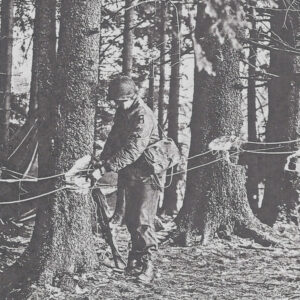In the past, the term “combat arms” referred to the infantry, cavalry and artillery. Later, the “cavalry” was replaced by the “armor” branch.” Services such as engineers, ordnance, signal and others were considered to be supports for the combat arms. However, historians have recorded that many supporting troops became combat troops during the Battle of the Bulge. The same was true for administration personnel including those in combat arms units.
On December 16, 1944, Combat Command B (CCB) of the 9th Armored Division (AD) was preparing for an attack with the 2nd Infantry Division to capture the Roer River Dam. That mission was cancelled and, for the next several days and nights, CCB of the 9th AD and CCB or the 7th AD fought alongside in Belgium delaying the main enemy attack. It ended when both units withdrew on December 23, 1944 from St. Vith, Belgium.
During that period, CCB of the 9th AD had no contact with their 9th AD headquarters which was in Luxembourg. A part of CCB task force was the 14th Tank Battalion (Bn). Captain Frank Simons commanded the Bn Headquarters Company whose enlisted staff maintained the records of the battalion – the movements, locations, casualties, losses and the important Morning Report which is often a source for military history. At one point, Capt. Simons ordered his clerical personnel to exchange their pencils for their side arms (weapons) and join the tanks and infantry of CCB to stop or delay the enemy advance.
I was a tank platoon leader in the 14th Tk Bn with five tanks and 24 men. My combat orders and missions changed frequently during the combat as our higher command attempted to stop the enemy and armor attacks. On day I was ordered to protect our 9th Armored Engineers who were preparing a roadblock to halt an possible or anticipated enemy attack. This type of operation had not been part of our many months of training. How was it accomplished?
The platoon leader and the other two tanks in his section moved into enemy territory to select a location from where they could observe an approaching enemy and warn the engineers.. As for observation, only the tank commanders can observe since the gunners, tank gun loaders, drivers and bow gunners are inside the tank with their hatches closed. Consequently, tanks are highly vulnerable, particularly to infiltration by small groups such as an enemy infantry squad, So, the tanks were positioned to observe but also, that if hit by a surprise attack, the platoon leader could engage the enemy to cover the withdrawal of the other two tanks.
The tank platoon sergeant and his second tank remained with the engineers who were preparing the roadblock. Once the platoon leader had his tanks in position, his next action was to establish radio contact with the platoon sergeant, who could than alert the engineers. He made contact with his own tank and with another of this tanks to provide a back-up in case of a communication problem. Incidentally, higher authority had ordered “radio silence” which meant we could receive messages (such as orders) but could we could not transmit messages. Under certain conditions, there is a reason for this restriction. However, since the platoon leader was the “higher authority” in this combat situation he changed to orders to meet the need and the combat situation.
 The illustration shows the engineers at work preparing and wiring the trees alongside the road so they could be blown to block the passage of vehicles.
The illustration shows the engineers at work preparing and wiring the trees alongside the road so they could be blown to block the passage of vehicles.
The surrounding terrain was unfavorable to tracked and wheeled vehicles. This was an action under combat conditions. The engineers along with the tankers were engaged in a combat action. In this action, the tank platoon sergeant informed this platoon leader when the engineers had completed placing of demolitions. The three advance tanks then withdrew back to the engineer location and the leader reported the situation to higher headquarters. He was given another mission. It is not known how the roadblock was manned to detonate the charges since, to be effective, a roadblock should usually be covered by fire.
As a tactical note, when an enemy column is stopped by a roadblock, the defending unit should be prepared to first disable a vehicle in the rear which prevents the withdrawal of the vehicles between the disabled vehicle and the roadblock.
In a later operation during the Bulge, the engineers were placing demolitions on a bridge. This required them to enter the bitter cold water of the river. You can bet that tanks in their dry locations did not envy the engineers!
by Dee Paris, 9th Armored Division, 14th Tank Battalion
